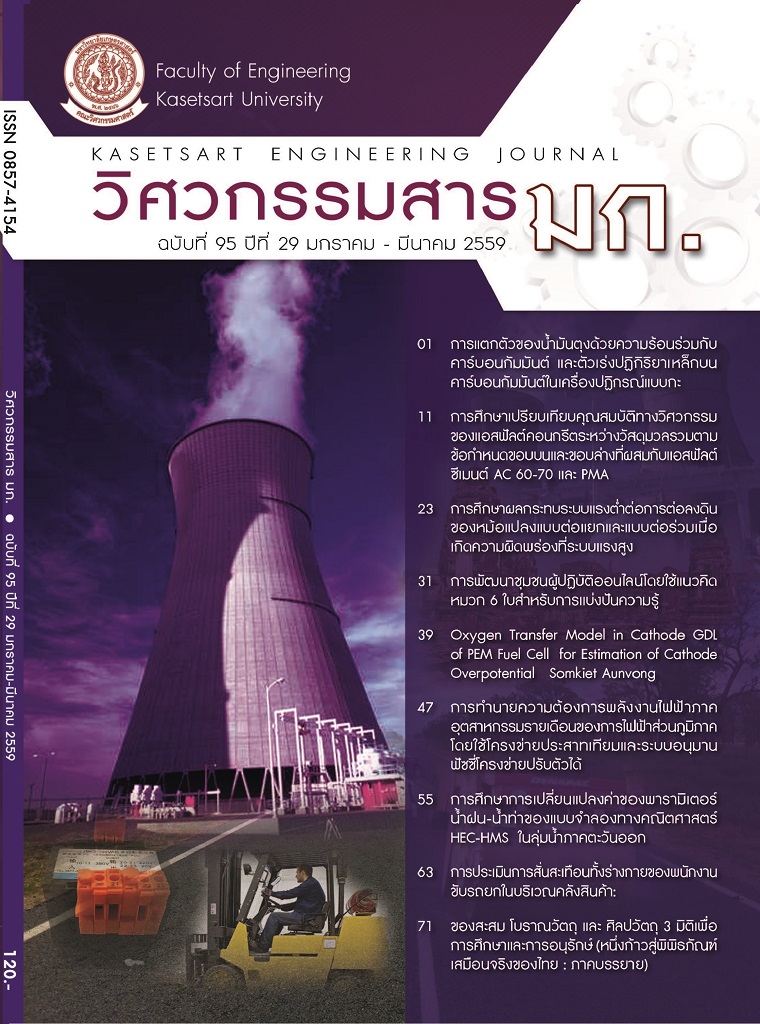การแตกตัวของน้ำมันตุงด้วยความร้อนร่วมกับคาร์บอนกัมมันต์ และตัวเร่งปฏิกิริยาเหล็กบนคาร์บอนกัมมันต์ในเครื่องปฏิกรณ์แบบกะ
Abstract
น้ำมันพืชที่ไม่ใช้บริโภคเป็นทางเลือกหนึ่งที่น่าสนใจสำหรับการสังเคราะห์เชื้อเพลิงเหลวเพื่อเป็นพลังงาน ทางเลือกทดแทนน้ำมันดิบจากฟอสซิลซึ่งมีปริมาณสำรองลดลง ดังนั้นงานวิจัยนี้จึงมีวัตถุประสงค์ศึกษาปัจจัยที่มีผลต่อการแตกตัวของน้ำมันตุงซึ่งเป็นน้ำมันที่ไม่ใช้บริโภคด้วยความร้อนร่วมกับตัวเร่งปฏิกิริยาในเครื่องปฏิกรณ์แบบกะภายใต้ความดันแก๊สไฮโดรเจน 1 บาร์เกจ เพื่อหาภาวะที่เหมาะสมของปฏิกิริยาการแตกตัว ปัจจัยที่ศึกษา ได้แก่ ชนิดของตัวเร่งปฏิกิริยา (คาร์บอนกัมมันต์ (AC) ตัวเร่งปฏิกิริยาเหล็กบนคาร์บอนกัมมันต์ (Fe/AC)) อัตราส่วนของเหล็กบนคาร์บอนกัมมันต์ 1 และ 5 wt% (1-wt% Fe/AC และ 5-wt% Fe/AC) อัตราส่วนของตัวเร่งปฏิกิริยาต่อน้ำมันตุง 0.5 และ 1.5 wt% (0.05 และ 0.15 กรัมของตัวเร่งปฏิกิริยาต่อน้ำ มันตุง 10 กรัม) อุณหภูมิทำปฏิกิริยา 390, 415 และ 440 °ซ และเวลาทำปฏิกิริยา 30, 45 และ 60 นาที ผลการศึกษาพบว่าได้ผลิตภัณฑ์ของเหลวสูงสุดที่อุณหภูมิ 390 °ซ และเวลา 30 นาที เมื่อใช้คาร์บอนกัมมันต์ต่อน้ำมันตุง 0.5 wt% และ 1-wt% Fe/AC ต่อน้ำมันตุง 0.5 wt% ในกรณี AC ต่อน้ำมันตุง 0.5 wt% วิเคราะห์ส่วนที่เป็นแก๊ส ผลิตภัณฑ์ของเหลว และของแข็งได้ 12.36, 84.95 และ 2.69 wt% ตามลำดับ ส่วนกรณีของ 1-wt% Fe/AC ต่อน้ำมันตุง 0.5 wt% ได้ 6.58, 89.63 และ 3.79 wt% ตามลำดับ และจากการวิเคราะห์องค์ประกอบในผลิตภัณฑ์ของเหลวจากการแตกตัวด้วยแก๊สโครมาโทกราฟพร้อมซอฟต์แวร์จำลองการกลั่น (Simulated Distillation Gas Chromatograph) ตามมาตรฐานASTM D2887 ผลิตภัณฑ์ของเหลวที่ได้จากการแตกตัวด้วยคาร์บอนกัมมันต์ประกอบด้วยแนฟทา 7.76 เคโรซีน 8.22 แก๊สออยล์เบา 26.97 แก๊สออยล์หนัก 5.08 และกากน้ำมันหนัก (Long Residue) 36.92 wt% สำหรับองค์ประกอบในผลิตภัณฑ์ของเหลวที่ได้จากการแตกตัวด้วย 1-wt% Fe/AC ประกอบด้วยแนฟทา 12.06 เคโรซีน 10.88 แก๊สออยล์เบา 25.68 แก๊สออยล์หนัก 9.06 และกากน้ำมันหนัก 31.95 wt%
Thermal and Catalytic Cracking of Tung Oil using Activated Carbon and Fe/Activated Carbon Catalyst in a Batch Reactor
Non edible oils are one of attractive raw materials to synthesize liquid fuels which are potential alternative energy as the petroleum reserve is decreasing. This research aims to study parameters that affect thermal and catalytic cracking of Tung oil, a non edible oil, in a batch reactor at a constant hydrogen pressure of 1 barg to determine the optimum conditions. The influences of several parameters were investigated: types of catalysts (AC, Fe/AC), the ratio of Fe on activated carbon 1-wt% and 5-wt% (1-wt% Fe/AC และ 5-wt% Fe/AC), the ratio of catalyst to Tung oil of 0.5 and 1.5 wt% (0.05 and 0.15 g catalyst : 10 g Tung oil), reaction temperature of 390, 415 and 440 °C and reaction time of 30, 45 and 60 minutes. The maximum liquid product was achieved at 390 °C and 30 mins by using activated carbon to Tung oil 0.5 wt%, and 1-wt% Fe/AC to Tung oil 0.5 wt%. As a result, gas, liquid and solid fractions were found to be 12.36, 84.95 and 2.69 wt%, respectively when 0.5 wt% activated carbon was used. In the case of 1-wt% Fe/AC to Tung oil 0.5 wt%, gas, liquid and solid fractions were 6.58, 89.63 and 3.79 wt%, respectively. The compositions in liquid product were analyzed by the simulated distillation gas chromatograph based on ASTM D2887. By using the activated carbon, the cracked liquid product consisted of naphtha 7.76, kerosene 8.22, light gas oils 26.97, heavy gas oils 5.08 and long residue 36.92 wt%. For 1-wt% Fe/AC, liquid product consisted of naphtha 12.06, kerosene 10.88, light gas oils 25.68, heavy gas oils 9.06 and long residue 31.95 wt%.


